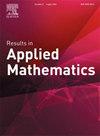仿射表示下的Wallach比值原理
IF 1.4
Q2 MATHEMATICS, APPLIED
引用次数: 0
摘要
受Heller(2014)的启发,并补充他们的研究结果,本文的主要目标是研究近靶与瓦拉赫比率原理和近靶与光照不变性,假设比以前的工作更一般的心理物理表征。我们采用了一种基于泛函方程的模型创建技术,分别研究了这些现象的仿射和增益控制型表示。本文章由计算机程序翻译,如有差异,请以英文原文为准。
Wallach’s ratio principle under affine representation
Motivated by Heller (2014) and supplementing the results found there, the main objective of this paper is to study the near-miss to Wallach’s ratio principle and the near-miss to illumination invariance, assuming more general psychophysical representations than in the previous works. We employ a model-creation technique founded on functional equations to study the affine and gain-control type representations of these phenomena, respectively.
求助全文
通过发布文献求助,成功后即可免费获取论文全文。
去求助
来源期刊

Results in Applied Mathematics
Mathematics-Applied Mathematics
CiteScore
3.20
自引率
10.00%
发文量
50
审稿时长
23 days
 求助内容:
求助内容: 应助结果提醒方式:
应助结果提醒方式:


